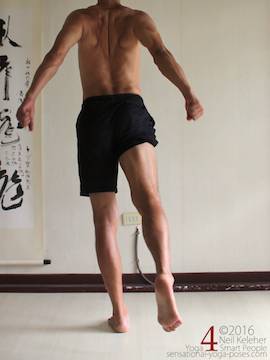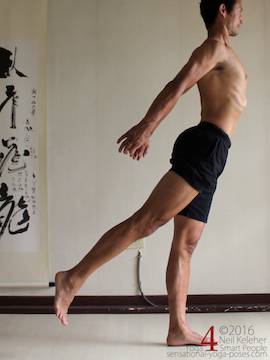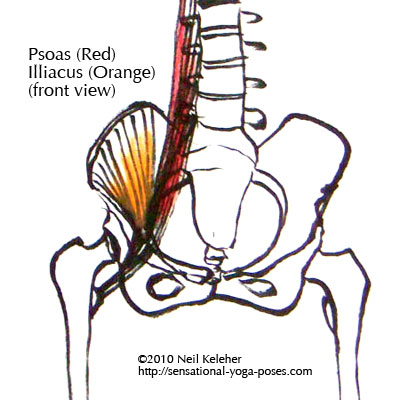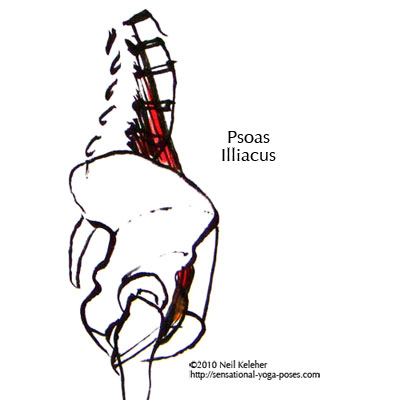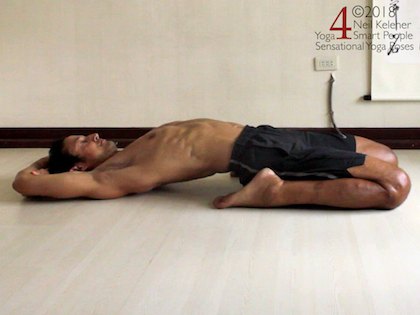Psoas Anatomy
Hip flexion, deeper stretching, preventing lumbar shear
On page cat links
Psoas stretch
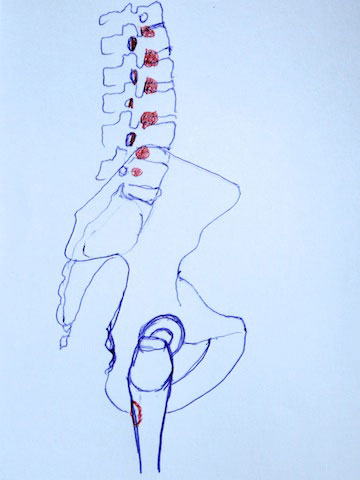
The psoas major has 6 fascicles on each side that attach to the sides of the bodies of the Lumbar Vertebrae (from top to bottom called L1, L2, L3, L4 and L5) as well as to the body of the lowermost thoracic vertebrae (T12). In some cases there is no attachment to L5. These same fascicles also attach to the discs between these vertebrae. Viewed from the side, the attachment points are behind the midline of the body of the vertebrae.
The Psoas muscle also has 5 more fascicles (on each side) that attach to the fronts of the transverse processes of the lumbar vertebrae.
The lines of pull of each of the lowermost fascicles can be used to cause the lower lumbar vertebrae (L4 and L5) to tilt forwards. The upper fascicles (acting on T12, L1, L2 and L3) can cause their respective lumbar vertebrae to tilt forwards if the lumbar spine is already curving forwards. If it is bent backwards then these fascicles can be used to cause those vertebrae to tilt further backwards.
So depending on the bend that that lumbar spine already has, the psoas accentuates that bend. And so rather than being a flexor or extensor, working against the spinal erectors, the psoas is acting to stabilize the lumbar spine however it is "shaped" or "bent".
(Read psoas muscle for another point of view on this.)
Using the Psoas to Flex the Hip
When using the psoas to flex one hip, say while standing, it may help to think of the lumbar spine as a tensioning device. When the pelvis tilts forwards to increase lumbar lordosis (increasing the arch of the lumbar spine) then the psoas is given some slack. When the pelvis tilts backwards to reverse the lordosis (flattening the lumbar spine) then any slack in the psoas is removed.
Lifting one knee towards the chest while upright, as the knee approaches the chest the active psoas shortens. There comes a point at which the psoas can no longer effectively contract. One way to give the psoas more room to contract is to tilt the pelvis backwards and reduce lumbar lordosis.

Pelvis tilted forwards.
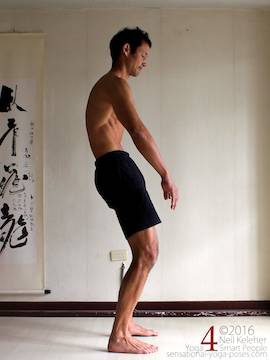
Pelvis tilted backwards.
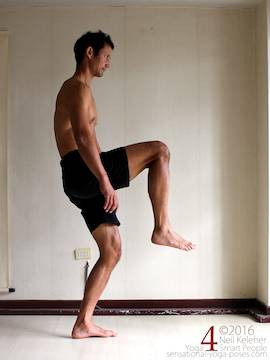
Hip Flex with knee bent
Imagine that the goal, while standing is to bring the knee to the chest.
Initially this comes from lifting the knee and bending the hip forwards but at a certain point the psoas is too short too effectively contract and so then the pelvis is tilted rearwards. This then helps to bring the knee closer to the chest by moving the pelvis relative to the ribcage. Rather than it being one action (flex the knee) and then another (tilt the pelvis backwards) the two can happen more or less simultaneously. The pelvis is tilted rearwards as the knee is lifted.
Active Psoas Stretches
To stretch the psoas by extending the hip while standing, it can be helpful to first increase lumbar lordosis by tilting the pelvis forwards. Make sure that your lumbar spinal erectors are active. Then reach one leg rearwards. In this case use the gluteus maximus and hamstrings to stretch the psoas of the lifted leg.
You could give this psoas stretch a floor assist in upright lunge, upright pigeon or even upward dog. But rather than pressing the floor, imagine trying to reduce foot pressure of the back foot or feet. Use your spinal erectors, gluteus maximus and hamstrings to bend your spine and hip(s) backwards.

High Lunge
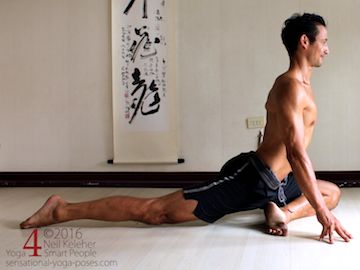
Upright Pigeon
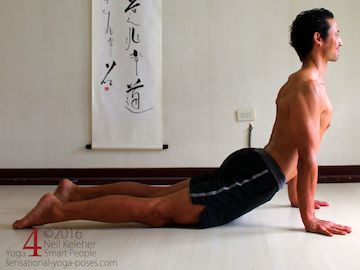
Upward Dog
When trying to stretch or activate the psoas by moving the leg or when trying to stretch it, you may be better off "stabilizing" the individual vertebrae of the lumbar spine so that they can't move relative to each other.
Another alternative is to stretch the psoas with the lumbar lordosis flattened as in the reclining psoas stretch or as in this standing psoas stretch.
Iliopsoas (The Union of Iliacus and Psoas Major)
The Iliacus muscle attaches at one end to the inside surface of the pelvis.
As the fibers of the psoas major muscle reach down towards the front of the pelvis, the fibers of iliacus blend with it. This is why, often, the two muscles are labelled as one, iliopsoas.
Using the lesser trochanter of the thigh as an anchor point, the fascicles of these muscles (psoas and iliacus) can act together to tilt the pelvis, lumbar spine (and via them the ribcage) forwards as one unit.
Psoas fiber direction variations
With the body upright, the upper fibers of the psoas can be thought of as pointing downwards and slightly forwards to the front of the pelvis. When active these fibers can cause a compressive force to act on the lumbar spine and the discs that cushion it.
Because of the curve of the spine and the less steep angle of the lower fibers of the psoas, the lower fibers of the psoas pull forwards on the lower lumbar vertebrae, causing a possible shearing action between L5 and the top of the sacrum or between L4 and L5 in cases where the L5 fascicles are absent.
Is lumbar shearing caused by psoas in straight leg sit ups?
One situation in which this "shearing" action is thought by some to be quite intense (damagingly so) is when doing a straight leg sit-up.
In a straight leg sit up the abdominals lock the pelvis, lumbar spine and ribcage together. When activated, the psoas pulls (and tilts) the whole upper body upright while the abs keep the lumbar spine straight. In this situation the shearing force generated by the lower fascicles of psoas major on the joint between L5 and S1 (the top of the sacrum) is thought to be quite severe. It is as if the psoas is acting to pull the lumbar spine off of (or slide it off of) the top of the sacrum.
At least that's the theory.
I would suggest that with the abdominals engaged, and keeping the lumbar spine straight or even slightly bent forwards while "sitting up" there is no shear force. Think of the psoas and iliacus acting to tilt the pelvis and lumbar spine forwards together.
Personally I've felt sheer forces while doing another pose, reclining hero.
What lumbar shear can feel like
Both my rectus femoris and lower psoas fibers are quite tight and in reclining hero pose the two of them together contrive to keep my pelvis tilted forwards as I lean back. With the top of my head on the floor I can feel rectus femoris but I can also feel the lower fibers of my psoas pulling L5 forwards.
It is not at all comfortable.
I don't feel the same "pull" when doing straight leg sit-ups and so in my case I feel it is safe to say that straight leg sit ups are safe.
How to Prevent lumbar shear when doing reclining hero
So how do I avoid the pulling sensation when doing reclining hero pose? I engage my abs before I lean back. I then use the weight of my upper body to tilt my pelvis back. This lengthens rectus femoris and the lower fibers of psoas major and then I can comfortable rest with my lower and upper back on the floor. Then I can focus on lengthening psoas major even more by drawing my lower back ribs away from my pelvis. (More on that below.)
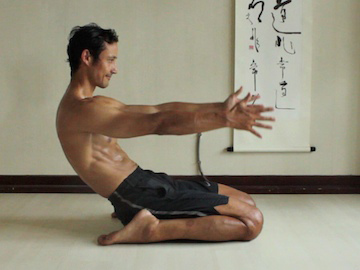
Hero pose with abs engaged spine curved forwards.
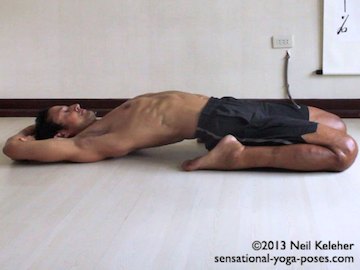
Hero pose with upper back on the floor.
Tips for engaging the abs when doing reclining hero
If you have trouble engaging your abs in reclining hero try lifting your head. Even if you can't lift if off of the floor pull it upwards. You may find your abs engage. To further engage them try curling your upper back off of the floor. Try doing both actions slowly and smoothly. And release them in the same way.
How the psoas connects to the kidneys
The psoas is connected, via connective tissue, to the kidneys. They in turn are connected to the diaphragm. And the diaphragm connects, in part, to the lower back ribs (the 12th set or ribs).
Generally, when you contract your diaphragm it presses downwards causing the abdominal organs to press your belly forwards as you inhale.
However, in order to press down on the organs of the abdomen the fibers of the diaphragm pull upwards on their attachments to the ribs. Hence while inhaling you can use your respiratory diaphragm to deliberately pull up on your 12th set of ribs. In the process you can hoist your kidneys upwards. They'll pull upwards on the connective tissue at the front of the psoas as you do so making your psoas longer.
Lifting the ribs for a more effective psoas stretch
If you are trying to stretch your psoas you can focus on lifting your ribs to create a more effective stretch. If you are trying to use your psoas to help in flexing your hips, lifting your ribs, particularly the 12th set, can give your psoas major the room it needs to contract so that it helps in your forward bend.
Read psoas musclefor more on activating or stretching the psoas, particularly the lower fibers.
Published: 2011 02 14
Updated: 2021 01 29




